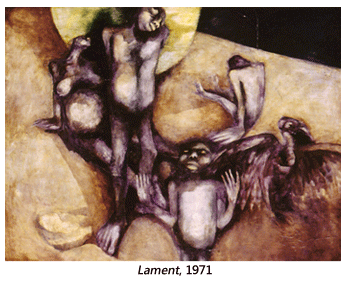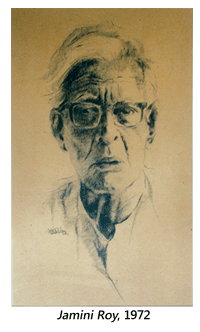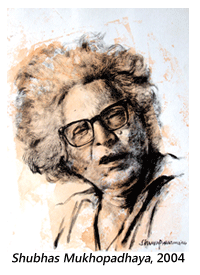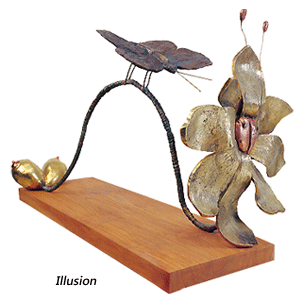- Publisher's Note
- Editorial
- Sixteen printmakers talk about their work
- The Imprinted Body
- A Chai with Vijay Bagodi
- The Wood Engravings of Haren Das
- A Physical Perception of Matter
- Feminine Worlds
- A Rich Theater of Visuality
- A Medley of Tradition
- Decontextualizing Reality
- Printmaking and/as the New Media
- Conversations with Woodcut
- Persistence of Anomaly
- Sakti Burman - In Paris with Love
- Lalu Prasad Shaw: The Journey Man
- Future Calculus
- A Note on Prints, Reproductions and Editions
- A Basic Glossary of Print Media
- The Art of Dissent: Ming Loyalist Art
- Vishnu: Hinduism's Blue-Skinned Savior at the Brooklyn Museum of Art
- Twelfth edition of Toronto International Art Fair
- Vintage Photographs of the Maharajas
- Göteborg International Biennial
- A Museum, a Retrospect & a Centenary for K.K. Hebbar:
- Recent and Retrospective: Showcase of Shuvaprasanna's Work
- "I Don't Paint To Live, I Live To Paint": Willem de Kooning
- Salvador Dali Retrospective: I am Delirious, Therefore I am
- To Be Just and To Be Fair
- Census of Senses: Investigating/Re-Producing Senses?
- Between Worlds: The Chittaprosad Retrospective
- Awesomely Artistic
- Random Strokes
- Counter Forces in The Printmaking Arena and how to Counter them
- Shift in focus in the Indian Art Market
- What Happened and What's Forthcoming
- Art Bengaluru
- Mumbai Art Sighting
- Musings from Chennai
- Art Events Kolkata
- Previews
- In the News
ART news & views
Recent and Retrospective: Showcase of Shuvaprasanna's Work
Volume: 4 Issue No: 21 Month: 10 Year: 2011
Review
by Sumitra Sunder
Bengaluru: It was the year of Independence, and truly so. One of the most Independent artists' arrived awaiting the legacy of Modernism in India. Shuvaprasanna'e oeuvre extends form fantastic cityscapes to hyper realist portraits. From his beginning in the late 60's to the present his work has evolved, to be surpassed by very few artists.
The works on display at the Galleries in Karnataka Chitrakala Parishath art Complex span three decade's of the Artist's work, the largest number being from the past ten years. Originally intending to have a solo show for Shuvaprasanna's work, Gallery Time and Space has now decided to put up a collection of recent and past works of the artist.  The show will be moving to Kolkata next according to the organizers. There is a huge body of work on display and the collection showcases the artist's versatility in all mediums. The Largest selection of work is form the past ten years, including one of the Artists latest Murals which is displayed in the basement of the Karnataka Chitrakala Parishath galleries.
The show will be moving to Kolkata next according to the organizers. There is a huge body of work on display and the collection showcases the artist's versatility in all mediums. The Largest selection of work is form the past ten years, including one of the Artists latest Murals which is displayed in the basement of the Karnataka Chitrakala Parishath galleries.
Shuvaprasanna is a Kolkata based artist, who has been an active member of the “Calcutta Painters Group”. He was a student at Rabindra Bharati University and graduated from the Indian College of Art in 1969. He also founded the College of Visual arts in Kolkata in 1974. His work revolves around social issues and the city of Kolkata. His work during the 60's and 70's were influenced by the political turmoil faced by the city during those decades. He has stated that “…There isn't another city like Kolkata anywhere in the world. In the heart of it, I find innumerable themes, subjects…"
As with many artists, it is difficult to disassociate Shuvaprasanna's work with the politics of the time. The artist is a staunch advocate of Democracy and in the past decade has thrown his weight behind campaigns for Trinamool Congress leader Mamata Banerjee. His works in the 60's and 70 does reflect the turbulent state that his beloved city went through. Apart from the cityscapes,  there are a number of paintings that reflect the turbulent times that the artist lived in. For example “lament”, painted in 1971, is a composition of human and animal figures against a rather flat background. Using greys and earth tones, the work has a very somber look.
there are a number of paintings that reflect the turbulent times that the artist lived in. For example “lament”, painted in 1971, is a composition of human and animal figures against a rather flat background. Using greys and earth tones, the work has a very somber look.
Lament, 1971
Apart from cityscapes, there are a small series of portraits also on display. These works are exquisite in detail and mark a significant departure from his usual style of portrayal of subjects. "To Shuvaprasanna complete abstraction is too artificial, too 'lifeless', too wide away from the direct approach of human relations in a city like Calcutta. …His presentation of reality often has dream-like elements in it. But does not the dream often show a deeper view of reality?"
"...in spite of all universality of the assessment Shuvaprasanna is not simply 'westernized'. Just on the contrary, he is an Indian by conviction, a Bengalee by passion and a Calcuttan out of his love for the city." (Ralf Oestreich).
Jamini Roy, 1972
Subhas Mukhopadhyaya, 2004
Illusion

The subject matter of the sculpture is whimsical and are often a metaphorical.
The cityscapes in Shuvaprasanna's work are grim, composed almost entirely of harsh lines and dark colours. A marked contrast is his works based on mythology. The series of paintings, Icons and Illusions, marked a creative breakthrough for the artist in a number of ways. While the treatment of figures remains angular, the colours here are bright and give a certain buoyancy to the work. According to the artist his childhood impressions of stories of the “devi” in Mahishasuramardini made sense and he felt that he wanted to “represent myths with a contemporary sensibility”.
Explaining his thought-process and philosophy as a painter, he notes: "What every creator  wishes to achieve is a universal appeal… One should go beyond themes, beyond words. There can be no clear cut definition for feelings, nor should you wish to seek any logical explanation." Right after studying, Shuvaprasanna had been organising groups for collective action. At 22, he had created the Society for Art and Artists. He was an active part of the Calcutta Artists Group, along with other socially committed artists like Jogen Chowdhury and Nikhil Biswas. Later, there was the College of Visual Art and, decades later, his friendship with writer Gunter Grass led to the creation of a lively art centre the Arts Acre. Grass deepened his instincts by telling him, “Don't be an ignorant man. Go and learn about the people.” Shuvaprasanna has never stopped trying. At 65, he jokes he doesn't mind going everywhere as long as he can eat at home.
wishes to achieve is a universal appeal… One should go beyond themes, beyond words. There can be no clear cut definition for feelings, nor should you wish to seek any logical explanation." Right after studying, Shuvaprasanna had been organising groups for collective action. At 22, he had created the Society for Art and Artists. He was an active part of the Calcutta Artists Group, along with other socially committed artists like Jogen Chowdhury and Nikhil Biswas. Later, there was the College of Visual Art and, decades later, his friendship with writer Gunter Grass led to the creation of a lively art centre the Arts Acre. Grass deepened his instincts by telling him, “Don't be an ignorant man. Go and learn about the people.” Shuvaprasanna has never stopped trying. At 65, he jokes he doesn't mind going everywhere as long as he can eat at home.